Regenerative Agriculture Puts the Soil First
How cover crops, crop rotation and using livestock to fertilize fields puts local farmers on the front lines in reducing climate change.
On a winter’s day in 2020, just weeks before the world went into pandemic lockdown, more than 100 foodies and farmers gathered at Monora Park Pavilion in Orangeville to hear how soil renewal can help reverse climate change. The daylong symposium, put on by Headwaters Food and Farming Alliance and organized by self-described “wannabe farmer” Marci Lipman, was headlined “Build Resilience into Your Soil.” Since that event, Marci, a longtime champion of the annual Dufferin Farm Tour, has become a vocal ambassador for what is known in farming circles as regenerative agriculture.
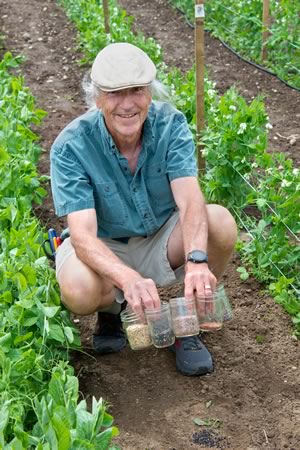
Jamie Richards plants Dutch white clover, buckwheat, oats, oilseed radish and forage peas to become “green manure” between his crop rows. Photo by Pete Paterson.
It all began when local farmer Jamie Richards lent Marci a book by David Montgomery, called Growing a Revolution: Bringing Our Soil Back to Life, and directed her to a TED Talk by Simcoe County farmer Gillian Flies of The New Farm. As a result, Marci says, “My eyes were opened to something I knew nothing about, and I wanted to get my farmers into a room to talk about it.” She realized the best way to spread the word would be through peer-to-peer learning. “We have to get farmers who are doing this to teach their neighbours.”
Speakers at the symposium, which Jamie helped organize, included environmentalists, conservation authority reps and, of course, farmers, all extolling the importance of healthy soil to the food we eat and to the planet as a whole.
So, what is regenerative agriculture? Well, imagine a system of producing food that is not only sustainable but promises to reduce carbon emissions. Many conventional farming methods, such as the use of chemical herbicides and pesticides, have long been bête noirs of conservationists and environmentalists. What’s more, ploughing and tilling release carbon dioxide into the atmosphere and tend to degrade the soil by destroying the diversity of microbes, fungi, mites, earthworms and bacteria that nourish plant growth and sequester carbon.
According to Kiss the Ground, a U.S.-based organization dedicated to helping farmers shift to regenerative practices, the U.S. is losing four tonnes of topsoil per acre per year. Conventional farming, the organization says, destroys the soil-building process. Regenerative agriculture is all about rebuilding healthy soil, thereby increasing its ability to hold and filter water, lowering the risk of flooding and decreasing evaporation. One of its central pillars is minimal or no tilling of the land.
Regenerative farming also relies on cover cropping, which fixes nitrogen in the soil, and crop rotation, which promotes microbial diversity in the soil. Perhaps the most surprising core element is the integration of livestock to fertilize the land. All these practices, in combination or individually, create conditions for plants to pull excess carbon out of the atmosphere and fix it into regenerated soil.
“It’s more of a systems approach depending on individual soils,” says Kari Dunfield, a soil microbiologist at the University of Guelph. In other words, farmers can adopt the practices that best suit their particular situations, making regenerative agriculture more flexible than organic certification’s strict standards. Additionally, methods like cover cropping and low tillage reduce farmers’ reliance on costly sprays, fertilizers and genetically modified seed.
Several farming operations in the Headwaters region have been ahead of the curve in embracing regenerative agriculture. Here are three whose environmental activism is inextricably wedded to their farming practices.
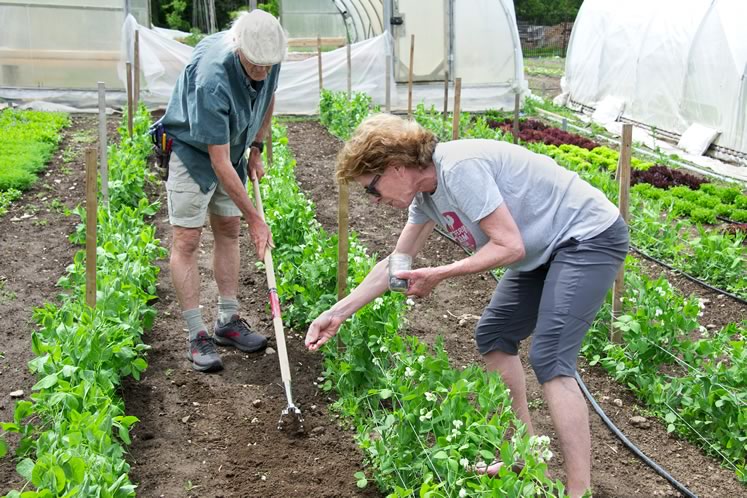
Jamie Richards of Am Braigh Farm in Mono assisted by visitor Marci Lipman. Photo by Pete Paterson.
Am Braigh Farm: Returning nutrients to the soil
One of the most enthusiastic promoters of good soil health is Marci’s mentor Jamie Richards. At his Am Braigh Farm in Mono he grows vegetables on a one-acre plot. In addition to the 20 varieties of vegetables he sells to local restaurants and at his farmgate store, Jamie raises chickens for their eggs and meat and, crucially, for their role in fertilizing his garden.
Like every farmer, Jamie knows the importance of good soil, but until he read David Montgomery’s book, he was caught in the same cycle as many other market gardeners. Each year he would till the soil, plant the crops, harvest, till again, plant, harvest, and repeat until the season ended. “I realized,” he says, “I was tilling way too much.”
Now his aim is to disturb the soil as little as possible. The whole principle is to build and maintain as much biological life in the soil as possible, to allow the natural fungi and soil bacteria to do the work that fertilizers do.
Instead of tilling, he covers the harvested area with large swaths of heavy, meshed tarp, and lets time and warmth work their magic. After a couple of weeks the soil underneath is a clear slate, rich with decomposed organic matter. Then Jamie plants cover crops: oats to put carbon into the soil, peas to fix nitrogen, and daikon radish in the fall to reach deep into the earth, doing the work a plough used to do.
Jamie’s 100 chickens are built into his crop rotation. Their foraging minimizes pests and weeds and fertilizes the soil. After a couple of years grazing an area, that area becomes a new garden bed. The old garden becomes the new grazing area so the chickens can work to improve its soil. Although Jamie has never used chemical fertilizers or insecticides, he notes, “The chickens produce considerable labour-saving by creating compost on site.”
Why is he doing this? “Philosophically, when I’m gone,” he says, “I would like to leave the world a little better than when I arrived.” But he has another important motive. “Economically, I am going to see a large return. The yields are pretty amazing,” he says.
Jamie says regenerative practices are gaining in popularity even among conventional farmers, who have been watching the regenerative movement with cautious interest. “Farming has thin margins and if something saves money, the news gets around.
“Healthy soil is so much more resistant to extreme weather events such as drought and heavy rain,” he says, explaining that a thriving and diverse biomass is like a giant sponge, able to absorb excessive rain and hold moisture during dry spells. Healthy soil also results in fewer pest problems. Is the resulting food more nutritious? No one knows for sure, but, says Jamie, “It sure tastes better.”
Every farm is different and each farmer will need to tailor their regenerative practices in an ongoing individual experiment. “Good farming,” says Jamie, “is good farming. And all farmers can agree that soil is important.”
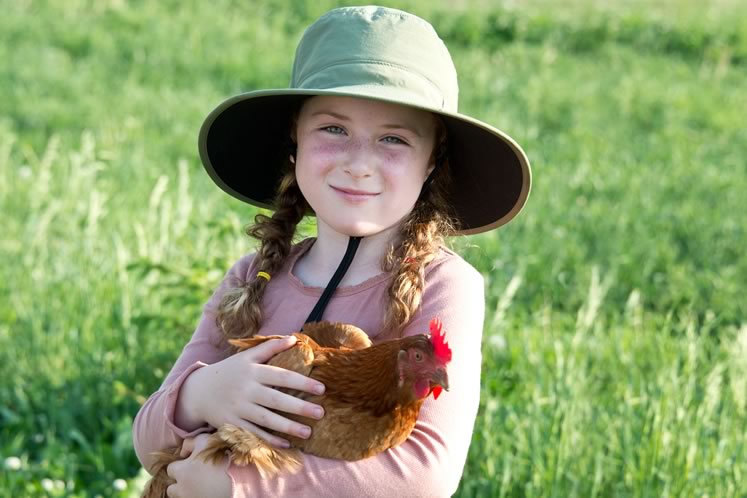
Amelia Roney of Bennington Hills Farm. Photo by Pete Paterson.
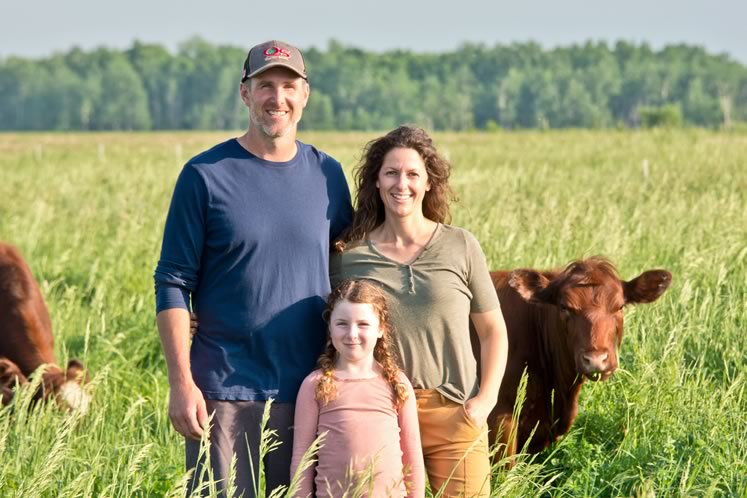
Jason Roney, Samantha Campbell and daughter, Amelia, 6, in lush pasture at Bennington Hills Farm. Photo by Pete Paterson.
Bennington Hills Farm: The importance of livestock
After saving up for years, in 2014 Jeff Roney and Samantha Campbell purchased land in Amaranth to realize their dream of becoming farmers. By 2017, Jeff had left his former career and was farming full-time on their 100-acre Bennington Hills Farm. While Samantha continues to work as a nurse practitioner at a medical centre in Grand Valley, she also works on the farm, where together they raise beef, lamb, pork and chickens. As a youth Jeff spent a lot of time on his grandfather’s farm near Mitchell, but both he and Samantha were determined to bring a more holistic approach to their farming operation.
According to Samantha, “The cow is the cornerstone of our farm.” She counters the prevailing cautions about meat consumption. “If you came to our farm and saw the animals, the way they live, it’s a hundred per cent okay to eat grass-fed beef the way we raise them.”
Rotational grazing, using a system of moveable fences, is key to building healthy soil. The Bennington Hills cattle are moved once or twice a day, mimicking the grazing patterns of wild herds of bison in pre-settlement North America, which stayed close together in small groups to protect against the predators that kept them moving across the landscape.
“Hooves on the ground,” says Jeff, “help incorporate uneaten plant matter and manure thereby fertilizing the soil, stimulating plant root growth and creating a nutritionally dense pasture.” And the no-till cash crops they rotate on separate fields mean carbon is sequestered in the soil instead of being released into the atmosphere.
Carbon sequestration, Jeff explains, is a process by which carbon dioxide is removed from the air and brought back into the soil through plants. Carbon in the ground is good for soil and feeds soil life, improving the health and quality of plants and animals. Planting crops like oats, chickpeas, quinoa and flax, along with non-GMO corn and soy means the fields are never bare and ensures a diversity of fungi and microbes in the soil.
“As well, our farm has over 4,000 trees,” says Jeff, which absorb more carbon, act as windbreaks and further reduce soil erosion.
This kind of holistic approach to food production means there are no one-size-fits-all solutions. Every farm is different, says Jeff. “You really have to pay attention to your particular environment. You have to go out in the field every day and wait and observe what happens.”
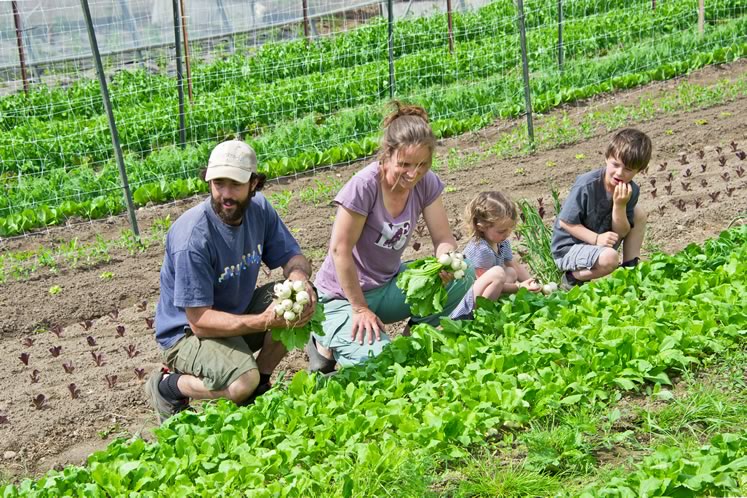
Graham Corbett, Amy Ouchterlony and youngsters Maeve, 4, and Owen, 7, reap a spring harvest at Fiddle Foot Farm. Photo by Pete Paterson.
Fiddle Foot Farm: The magic of healthy soil
Amy Ouchterlony and Graham Corbett, owners of Fiddle Foot Farm in Mulmur, know that farmers who adopt regenerative methods must tailor their practices to the physical realities of their farms. The couple grows a cornucopia of vegetables on their 66 acres of rolling and partially wooded land. “Everything but sweet corn and sweet potatoes,” jokes Graham.
Their bestsellers, which they distribute through Community Supported Agriculture shares and at Orangeville farmers’ market, are organic spinach, tomatoes, carrots and salad greens, but more exotic fare such as watermelon radish and kohlrabi are also popular with their customers. In the spring they also offer vegetable seedlings for sale to backyard gardeners.
Fiddle Foot has 5.5 acres under cultivation. The remaining land is too hilly or forested for planting crops. Instead, a small herd of eight cows grazes the steep-sided fields and gullies. Like the cattle at Bennington Hills, the cows are moved frequently, but unlike the Bennington animals, which live for 18 to 24 months before heading to the slaughterhouse, the oldest of Fiddle Foot’s cattle have been with Amy and Graham for most of the 14 years the pair has run the farm. The animals’ sole purpose is to generate the composted manure the couple uses to fertilize their vegetable gardens.
Rotation of grazing allows plant roots to remain strong, says Graham, and the cows leave behind manure, urine and saliva to feed the pasture without having time to destroy it. The result over time is pasture that is healthy and nutritious. Although the couple still tills their vegetable beds, they long ago reduced use of a rototiller in favour of a piece of equipment known as a bedmaker, which disturbs the soil only an inch or two.
“It is magic to see the soil improving,” says Amy, who views farming as a form of environmental activism. “We are doing something practical and productive.”
Standing on a hillside at the back of his property late last summer, the tall grasses jubilant with goldenrod and wild aster, Graham explains the importance of biodiversity in agriculture. The couple views everything on their farm as interconnected. “Wild spaces are integral to all of this, hosting pollinators and beneficial insects,” he says. “We are lucky to be surrounded here by such natural abundance.”
Kiss the Ground
With an investment in marketing, U of G’s Kari Dunfield thinks “regenerative ag” could become the next big thing, “once companies figure out that consumers will pay a premium for regenerative products.” A 2020, multi-award-winning film called Kiss the Ground, narrated by Woody Harrelson and viewed, according to the film’s website, by nearly 10 million people, has gone a long way to popularize the concept outside the agricultural community. General Mills is already investing in efforts to achieve widespread adoption of healthy soil practices, partnering with organizations that help farmers who want to make the transition.
Like so many before them this new breed of farmers wants to keep farming. They want their families to keep farming, and so building healthy soil just makes sense, says Marci Lipman. “I think there’s a big transition happening in farming and it’s driven by younger farmers. It’s also about climate change.”
That’s why she intends to hold more events like the Monora Park symposium. “It’s not only about educating the farmers, it’s about educating the public. They care about where their food comes from. They’re reading labels now and that’s really important. If they see a label that says ‘Regenerative Agriculture,’ they have to know what it means.”
Related Stories
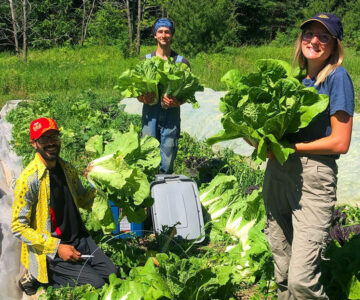
Regenerating Our Relationship with the Land
Jun 16, 2023 | | FarmingPick up this year’s Headwaters Farm Fresh guide to get to know your local farmers and explore the beautiful countryside in our own backyard.

The Boom in Local Food
Jun 25, 2020 | | FoodIn the dark cloud of the pandemic, a silver lining for small farmers.
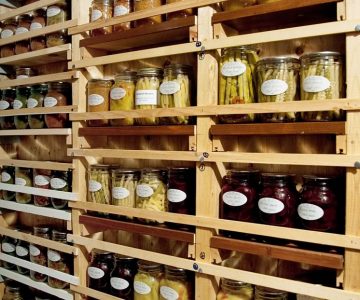
From Soil to Table
Sep 18, 2020 | | FarmingVegetable grower extraordinaire Karen Hollingshead uses galvanized steel raised beds and water troughs to hold her 35 varieties of tomatoes and other gems.

Farmers at the Table
Sep 24, 2021 | | FarmingThree Dufferin farmers sit down talk about what it means to be a modern farmer, the challenges they face and what they wish we knew about them.











